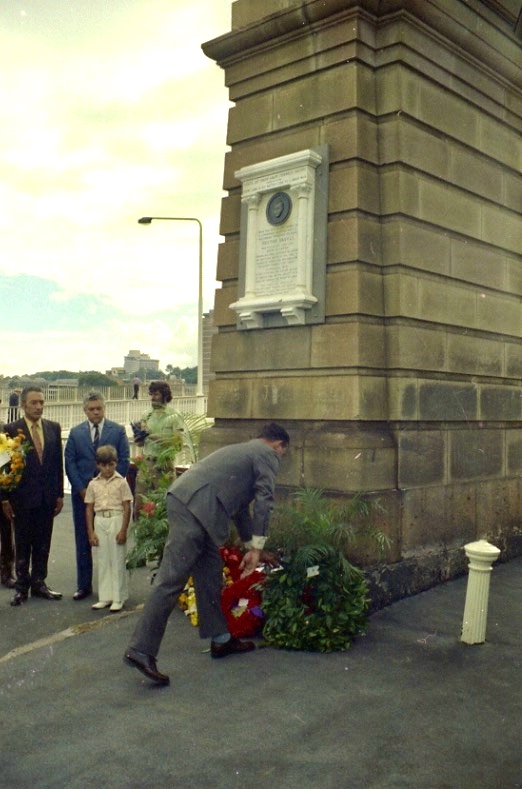Anzac Day 2020 – Remember them, Honour them
George Albert Crutchfield 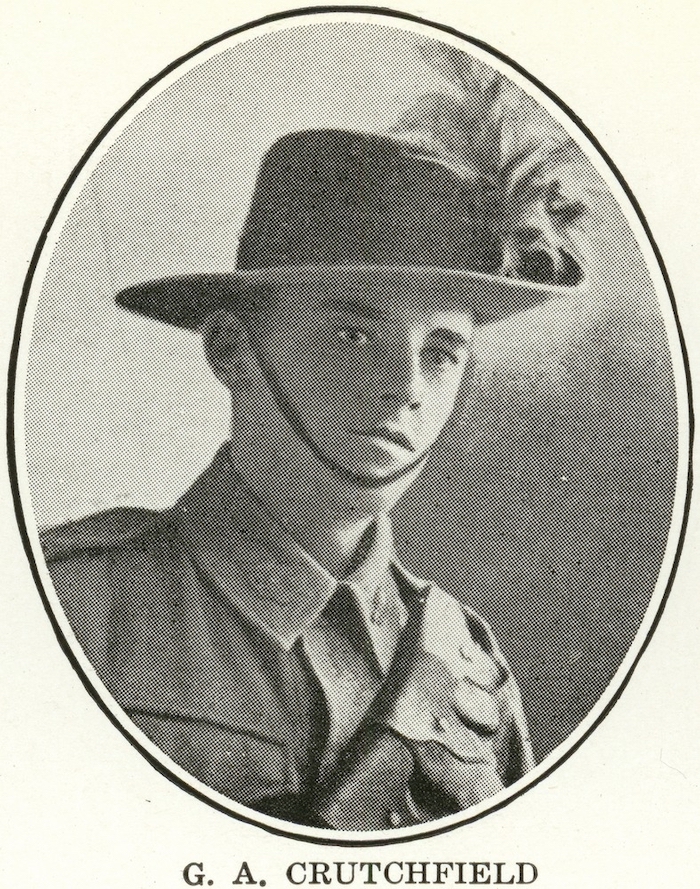
Portrait of G A Crutchfield. (State Library of Queensland, Discovering Anzacs collection)George Albert Crutchfield, born in Owhara, New Zealand, was the son of Charles Crutchfield and Maria Kaiser Magnall. After the death of his father in 1900 his mother remarried and George and his brother Charles moved to Australia and then joined the war effort. Both he and his brother considered their uncles Richard and George, their father’s brothers, as their father figures.
George enlisted on 14 December 1914 and joined the 5th Light Horse Regiment, 2nd Reinforcement. He was 22 and his occupation was shown as stockman. On his embarkation papers he nominated Richard Crutchfield as his father and next of kin. However, Richard Crutchfield was, of course, his uncle who lived in Redfern Street, Woolloongabba at the time.

The HMAT A53 Itria weighed 5,318 tons with an average cruise speed of 10 knots or 18.52 kmph. It was owned by the British India SN Co Ltd, London, and leased by the Commonwealth until 17 June 1917.
Private George A. Crutchfield boarded the HMAT A53 Itria on 9 February 1915 and left for Egypt, arriving at Suez in March 1915 and then went to the Maadi camp outside Cairo [where the Australian Light Horse brigades camped with their horses].

He left for Gallipoli on 22 July and stayed there until he was transferred to the hospital ship at Malta with colitis, re-joining his unit a few weeks later after his recovery.

On Christmas Day 1915 he disembarked from the HMAT A72 Beltana and then returned to Maadi where he joined the Sinai Desert Campaign. In February 1916 he marched out to Serapeum in Egypt. He broke camp on 13 March 1916 and was fined two weeks’ pay.

In August 1917 after some time in the Rest Camp at Port Said he went to Marakeb, Egypt. He was wounded in action at Beersheba on 10 November but remained on duty with the Egyptian Expeditionary Force until June 1918 when he was sent to the Port Said Rest Camp. He was promoted to Lance Corporal in September 1918 and a month later was admitted to hospital with influenza. He returned to duty a week later and remained until the signing of the Armistice Agreement. In March 1919 he went to England for a month’s leave. He left England on 9 July on the HMAT Prinz Ludwig returned to Australia on 8 September, he was discharged from the A.I.F. on 9 October 1919.
He died in Brisbane on 31 January 1972 at the age of 78 and was cremated at the Mt Thompson Crematorium.
Life at Maadi Camp, Sinai
Australian Light Horse Brigades camped with their horses at the Maadi, located 10 km from Cairo, Egypt. The 5th Light Horse Regiment were stationed in Maadi, when they arrived from Australia. Here they trained and gathered strength, awaiting orders to join the troops on Gallipoli in May 1915.

These pictures give us an insight into what life was like for the soldiers and their horses at the camp. They are part of a collection of photos relating to Sergeant Wilfred (Pat) Mapon Chaille, no. 530 who served with the 5th Light Horse Regiment, ‘A’ Squadron during the First World War held by the State Library of Queensland in the Picture Queensland series. Photos taken by Marion W. Croll. Description beside each photo.
This is the Ambulance stables in front, then the Army Service Corps, then the 5th & then the Army Vet. Corps. on the right are the 6th stables. The big tent in front is the 6th canteen.

Horses being watered at wooden troughs, 2nd Light Horse Field Ambulance encampment.
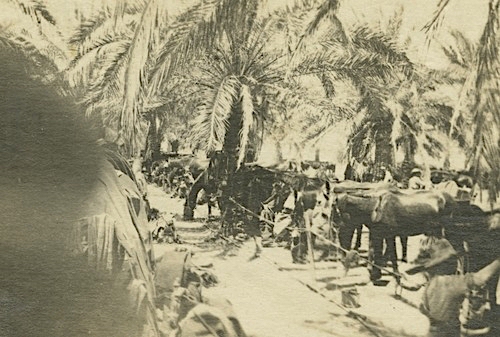
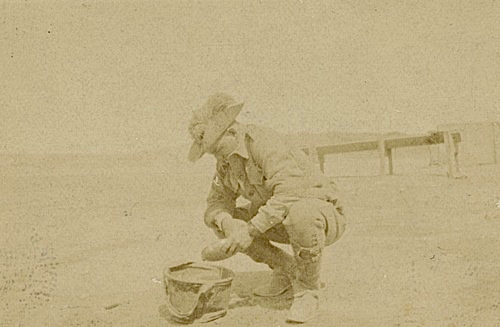
Charles Smethurst Snow
 Charles Smethurst Snow 1882-1953 founder of the Scouting Movement in Queensland, resident of Leckhampton on Shafston Ave, Kangaroo Point, choirmaster and organist at St Mary’s also served in the AIF (Australian Imperial Force).
Charles Smethurst Snow 1882-1953 founder of the Scouting Movement in Queensland, resident of Leckhampton on Shafston Ave, Kangaroo Point, choirmaster and organist at St Mary’s also served in the AIF (Australian Imperial Force).
He enlisted on 17 July 1919 and went to England, arriving in February 1918. He served as a mechanic in the Australian Flying Corps and was posted to No.1 School of Navigation and Bomb-dropping before being discharged from the army on 13 July 1919 in Brisbane. He then resumed his scouting interests.
Hector Vasyli – Patriotic Greek-Australian boy
On the Southern Abutment of the old Victoria Bridge built in 1886 is a beautiful tribute to a patriotic little eleven-year-old paper boy who saved his pocket money to buy treats of cigarettes, chocolates and flowers for returned soldiers.

On 9 June 1918, while watching a motor parade of sick and injured soldiers on their way to the Kangaroo Point Military Hospital (Yungaba) and throwing small gifts to the soldiers he was tragically hit by a car which was swerving to avoid a collision. He was taken to the nearby St Helens Hospital and the the Mater Hospital but unfortunately but unfortunately died of his injuries. He was buried at Toowong Cemetery.

The Returned Soldiers and Sailors League and the general public were deeply affected by Hector’s tragic death and together with the Hellenic Association organised a marble memorial plaque to honour him. It was placed on the wall of what was then the entrance to the pedestrian walkway of the bridge.

When the old bridge was demolished in 1966 for a new bridge the Southern Abutment and archway were kept and the Greek community looked after Hector’s memorial plaque during the construction period. It was restored to its original spot on the southern arch of the bridge in 1970.
The Victoria Bridge Abutment was heritage listed in 1992 and an access bridge to it was built in 2015. The Greek community hold a simple memorial service there for Hector on ANZAC Day every year.
On this day 50 years ago: Hector Vasyli memorial service
Here are some photos of one of the annual memorial services for Hector held on 25 April 1974, fifty years ago today at the Victoria Bridge Arch.
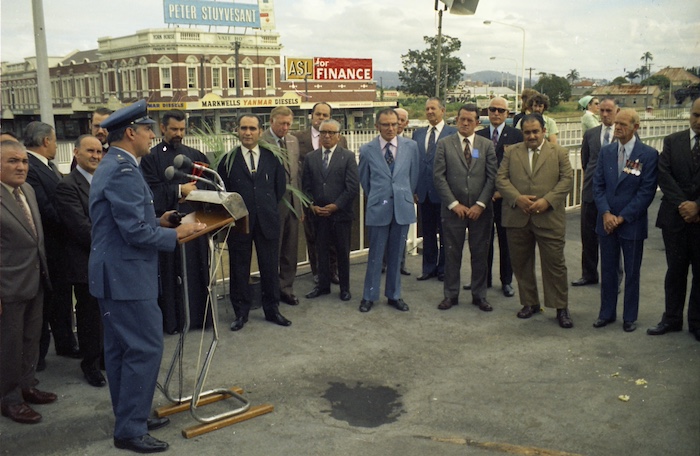
The photos are also interesting as a snapshot in time of the area in South Brisbane in the 70s. Prominent is York House Private Hotel at the intersection of Grey Street and Melbourne Street which was demolished and was originally proposed for the Queensland Art Gallery site, and is now the Museum corner.
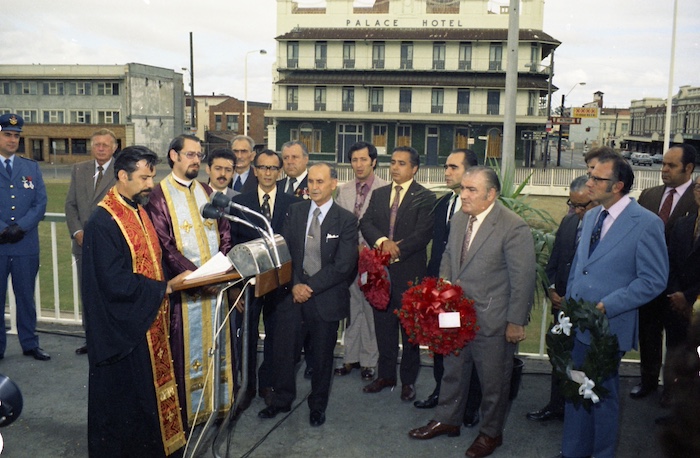
Also visible are the Palace Hotel and other older buildings.

